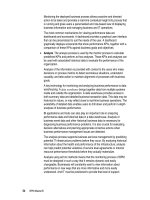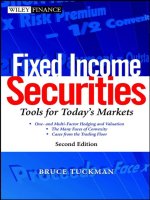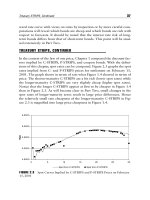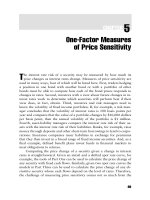Next generation excel modeling in excel for analysts and MBAs, 2nd edition
Bạn đang xem bản rút gọn của tài liệu. Xem và tải ngay bản đầy đủ của tài liệu tại đây (24.36 MB, 418 trang )
Next Generation
Excel
®
Founded in 1807, John Wiley & Sons is the oldest independent publishing company in
the United States. With offices in North America, Europe, Australia and Asia, Wiley is
globally committed to developing and marketing print and electronic products and
services for our customers’ professional and personal knowledge and understanding.
The Wiley Finance series contains books written specifically for finance and
investment professionals as well as sophisticated individual investors and their
financial advisors. Book topics range from portfolio management to e-commerce,
risk management, financial engineering, valuation and financial instrument analysis,
as well as much more.
For a list of available titles, visit our Web site at www.WileyFinance.com.
Next Generation
Excel
®
Modeling in Microsoft® Excel® for Analysts
and MBAs (for Windows® and Mac® OS)
Second Edition
ISAAC GOTTLIEB
John Wiley & Sons Singapore Pte. Ltd.
To my father, Yeshayahu Gottlieb, and to
Gilda, Edon, Sivan, David, Jonah, Ruby, and Lev
Copyright ª 2013 by John Wiley & Sons Singapore Pte. Ltd.
Published by John Wiley & Sons Singapore Pte. Ltd.
1 Fusionopolis Walk, #07-01, Solaris South Tower, Singapore 138628
All rights reserved.
First edition published by John Wiley & Sons Singapore Pte. Ltd. in 2010.
No part of this publication may be reproduced, stored in a retrieval system, or transmitted in
any form or by any means, electronic, mechanical, photocopying, recording, scanning, or otherwise,
except as expressly permitted by law, without either the prior written permission of the Publisher, or
authorization through payment of the appropriate photocopy fee to the Copyright Clearance
Center. Requests for permission should be addressed to the Publisher, John Wiley & Sons
Singapore Pte. Ltd., 1 Fusionopolis Walk, #07-01, Solaris South Tower, Singapore 138628,
tel: 65–6643–8000, fax: 65–6643–8008, e-mail:
Limit of Liability/Disclaimer of Warranty: While the publisher and author have used their best efforts
in preparing this book, they make no representations or warranties with respect to the accuracy or
completeness of the contents of this book and specifically disclaim any implied warranties of
merchantability or fitness for a particular purpose. No warranty may be created or extended by sales
representatives or written sales materials. The advice and strategies contained herein may not be
suitable for your situation. You should consult with a professional where appropriate. Neither
the publisher nor author shall be liable for any loss of profit or any other commercial damages,
including but not limited to special, incidental, consequential, or other damages.
Microsoft and Excel are registered trademarks of Microsoft Corporation.
Mac and Mac OS are trademarks of Apple Inc., registered in the U.S. and other countries.
Other Wiley Editorial Offices
John Wiley & Sons, 111 River Street, Hoboken, NJ 07030, USA
John Wiley & Sons, The Atrium, Southern Gate, Chichester, West Sussex, P019 8SQ,
United Kingdom
John Wiley & Sons (Canada) Ltd., 5353 Dundas Street West, Suite 400, Toronto, Ontario,
M9B 6HB, Canada
John Wiley & Sons Australia Ltd., 42 McDougall Street, Milton, Queensland 4064, Australia
Wiley-VCH, Boschstrasse 12, D-69469 Weinheim, Germany
Library of Congress Cataloging-in-Publication Data
ISBN
ISBN
ISBN
ISBN
978-1-118-46910-1
978-1-118-46909-5
978-1-118-46907-1
978-1-118-46908-8
(Hardcover)
(ePDF)
(Mobi)
(ePub)
Typeset in 10/12pt SabonLTStd by MPS Limited, Chennai, India
Printed in the United States of America.
10 9 8 7 6 5 4 3 2 1
“For wisdom is better than rubies, and all the things
one may desire cannot be compared with her.”
Bible, Proverbs (Chapter VIII, Verse 11)
Contents
Foreword
xv
Preface
xvii
Acknowledgments
xxi
PART ONE
Using Excel Efficiently
CHAPTER 1
AutoFill
AutoFill Options
Right-Drag AutoFill
Appendix: AutoFill in Excel 2003 and Excel Mac 2011
Review Questions
Answers
1
3
8
8
10
13
14
CHAPTER 2
Selecting Efficiently in Excel
15
Review Questions
Answers
18
19
CHAPTER 3
Formulas, Functions, and Relative and Absolute Addressing
Relative and Absolute Addressing
Other Functions
Appendix: Doing It in Mac Excel 2011
Review Questions
Answers
CHAPTER 4
Naming Cells and Ranges
Naming a Single Cell
Naming a Range of Cells
Using the Name Menu to Create Names
Appendix: Using the Names Menu in Excel 2003 and Mac Excel 2011
Review Questions
Answers
21
22
25
28
29
30
31
31
33
34
38
41
42
vii
CONTENTS
viii
CHAPTER 5
Conditional and Advanced Conditional Formatting in Excel
Simple Conditional Formatting; Adding a Rule
New Conditional Formatting Features
Advanced Conditional Formatting
Appendix: Using the Conditional Formatting in Excel 2003
Review Questions
Answers
CHAPTER 6
Excel Charts
Quick/Instant Chart
Creating a Chart Using the Menu
Adding More Data to an Existing Chart
More about Charts
Three-Dimensional Charts—Column and Pie
Pie Charts
Appendix: Generating Charts in Excel 2003
and Mac Excel 2011
CHAPTER 7
Sparklines and Advanced Topics in Excel Charts
Sparklines
More about Charts
Review Questions
Answers
45
45
46
49
52
53
55
57
57
57
61
64
66
70
73
81
81
83
90
91
PART TWO
IF Functions and Text Manipulations
CHAPTER 8
IF Functions
Simple IF Functions
Nested IF Functions
Nested IF—Payroll Example
Appendix: Using the IF Function in Mac Excel 2011
Review Questions
Answers
CHAPTER 9
Text Manipulation
Text to Columns
Appendix: Using Text to Column in Excel 2003
Review Questions
Answers
93
95
95
98
99
101
102
102
103
103
108
111
112
Contents
ix
PART THREE
Statistical Tools
CHAPTER 10
Descriptive Statistics
Descriptive Statistics
Appendix: Descriptive Statistics with the Mac Excel 2011
Review Questions
Answers
CHAPTER 11
Frequency Distributions
One More Example
Appendix: Frequency Distributions with Mac Excel 2011
Review Questions
Answers
CHAPTER 12
Statistical Regression
Using the Scatter Chart in Excel
Linear Regression—Using Excel Functions
Appendix: Using the Chart Feature to Create a
Trend Line in Excel 2003 and Mac Excel 2011
Review Questions
Answers
CHAPTER 13
Data Analysis—The Excel Easy to Use Statistics Add-In
Descriptive Statistics
Frequency Distribution Using Histogram
Appendix: Using Data Analysis in Excel Mac 2011 and Excel 2003
Review Questions
Answers
CHAPTER 14
Data Analysis—Multi-Regression
Simple or Single Variable Regression
Multi-Regression
Appendix: Using Data Analysis in Excel Mac 2011
and Excel 2003
Review Questions
Answers
113
115
115
117
119
119
121
126
129
129
130
131
131
133
137
140
140
141
141
143
148
148
149
151
151
152
160
160
161
CONTENTS
x
PART FOUR
What-If Analysis
CHAPTER 15
Naming Cells—For Meaningful Decision Making and Modeling
One More Example—If You Have a Ready Model
Appendix: Create and Apply Names in Excel 2003
and Mac Excel 2011
Review Questions
Answers
CHAPTER 16
What-If Analysis and Goal Seek
Goal Seek
Appendix: Goal Seek in Excel 2003 and
Mac Excel 2011
Review Questions
Answers
CHAPTER 17
Sensitivity Analysis—One- and Two-Way Data Tables
Two-Way Table
Data Tables—One More Example
Break-Even Point (BEP) Chart
Appendix: Sensitivity Analysis—One- and
Two-Way Data Tables for Excel 2003
and Mac Excel 2011
Review Questions
Answers
CHAPTER 18
Using Scroll Bars for Sensitivity Analysis
Scroll Bar Limitations
Appendix: Adding a Scroll Bar in Excel 2003, 2007,
and Mac Excel 2011
Review Questions
Answers
165
167
168
170
175
175
177
178
182
183
183
185
187
189
190
192
193
195
199
203
205
207
208
PART FIVE
Multi-Page Systems and Lookups
211
CHAPTER 19
Multi-Page Budgets—Going to the Third Dimension
213
A Payroll Example
A Second Example—Bakers’ Supplies
Review Questions
Answers
213
217
219
220
Contents
CHAPTER 20
Lookup Tables
Range—Approximate Match Lookup
An Exact Match Lookup
Review Questions
Answers
xi
221
221
224
227
228
PART SIX
The Data Menu and Ribbon
CHAPTER 21
Sorting Data
Sorting by Multiple Parameters
Appendix: Sorting in Excel 2003 and Mac Excel 2011
Review Questions
Answers
CHAPTER 22
AutoFilter
Dates
Below and Above Average
Filter by Color
Appendix: AutoFilter in Excel 2003
Review Questions
Answers
CHAPTER 23
Data Forms and Features Eliminated in Excel 2007 and 2010
Appendix: The Data Form in Excel 2003 or
Earlier versions and Mac Excel 2011
Review Questions
Answers
CHAPTER 24
Group and Outline Data
Appendix: Group and Outline Data Excel 2003
and Mac Excel 2011
Review Questions
Answers
CHAPTER 25
Excel Subtotals
One More Example—Function Applied to Multiple Categories
Copying Grouped Data
Second Example—Larger Database
Appendix: Creating Subtotals in Excel 2003 and Mac Excel 2011
Review Questions
Answers
229
231
233
236
238
239
241
241
243
243
244
246
247
249
251
252
253
255
258
260
261
263
265
265
269
269
273
273
CONTENTS
xii
CHAPTER 26
Pivot Tables
PivotTable Example
Appendix: The Pivot Table in Excel 2003 and Mac Excel 2011
Review Questions
Answers
CHAPTER 27
Data Mining Using Pivot Tables
Appendix: Advanced PivotTable Techniques in Excel 2003
Review Questions
Answers
CHAPTER 28
Using Slicers to Filter Pivot Tables
Format a Slicer
Sharing Slicers for More Than One Pivot Table
Review Questions
Answers
275
275
282
286
286
289
296
297
298
301
302
304
305
306
PART SEVEN
Excel Financial Tools
CHAPTER 29
NPV and IRR—Evaluating Capital Investments
The Time Value of Money
IRR—Internal Rate of Return
Review Questions
Answers
CHAPTER 30
Unconventional Financial Functions: XNPV and XIRR
Excel XNPV—The Net Present Value Function for Uneven Intervals
Excel XIRR—The Internal Rate of Return Function for Uneven Intervals
Review Questions
Answers
307
309
309
311
313
313
315
315
316
318
318
CHAPTER 31
Frequently Used Financial Functions
319
Similar Excel Functions
Review Questions
Answers
320
323
323
CHAPTER 32
Amortization Tables
Amortization Example
Review Questions
Answers
325
325
334
334
Contents
CHAPTER 33
Accounting Depreciation Functions
SLD Straight Line Depreciation
SYD Sum of the Years Digits
Review Questions
Answers
xiii
337
337
337
339
339
PART EIGHT
Using the Solver Add-In
CHAPTER 34
Beyond the Goal Seek—More Than One Changing Cell? Use the Solver
Example—Break-Even Point
Using the Solver
Appendix: Using the Solver in Excel 2003 and Mac Excel 2011
Review Questions
Answers
CHAPTER 35
The Solver Add-In—Optimizer
341
343
343
343
349
350
352
353
Solver Example
Nonlinear Example Using the Solver
Appendix: Using the Solver in Excel 2003 and Mac 2011
Review Questions
Answers
353
355
360
360
360
Appendix Summary Case Study—Supply Chain Management Example
365
About the Author
385
Index
387
Foreword
I
am pleased to write the foreword to this very practical and important book on
Excel by Professor Isaac Gottlieb. As Dean of the Fox School of Business at Temple
University in Philadelphia, I have personally known Dr. Gottlieb for several years
and can attest to his deep knowledge in this field. Excel is one of the most robust
business application tools of our time, and Professor Gottlieb is one of the foremost
experts in Excel. Professor Gottlieb teaches Statistics and Excel to graduate and
undergraduate students at Temple University. He is very passionate about teaching
and receives rave reviews in his classes. This book utilizes not only his many years of
using Excel on both PC and Apple, but also his teaching of courses and workshops in
many universities and corporations across the world. The many questions that have
been asked of him, including those sparked by his “tips of the month,” are distilled
in this book.
This book distinguishes itself in a number of ways. Even though the book utilizes
the latest version of Excel (2010), it explains how it differs from—and how to work
out the same tasks with—previous Excel versions (2007 and 2003). It even has a
special appendix in every chapter for Excel for Mac 2011, which has become
increasingly popular. Every topic and chapter includes real-world cases using the
most efficient Excel modeling to solve them. Chapters are followed by review
questions and solutions.
This book covers a number of concentrations most analysts and business students use today: finance, accounting, statistics, data mining, operations management,
and analytic techniques for decision-making. The capstone appendix is a detailed
supply chain management case study that combines all the techniques covered
throughout the book.
The majority of Excel users take advantage of only a very small portion of the
software. This book, with 35 chapters covering a variety of topical areas, unleashes
the incredible capacity and potential of Excel. Professor Gottlieb’s thorough explanations of these topics and hundreds of actual screenshots enhance readers’ ability
to understand and see how routines are performed and displayed. This book will be
useful to all who utilize Excel in their daily lives, be they casual users, students or
professionals.
M. Moshe Porat, Ph.D., CPCU
Dean
Laura H. Carnell Professor
Temple University
xv
Preface
I
have taught people how to utilize Excel for business since 1997. My focus has
always been on the applications needed in a business environment.
Because of years of teaching the application’s extensive possibilities, I have found
that systematic and hands-on approaches are the most effective.
When you get to the heart of the matter, you will find that the author is speaking
to the reader, as I am doing now. This book was voluntarily written in a very
informal tone, to keep the learning process as dynamic as it can be in a classroom or
workshop setting.
I wanted to create a book that appeals to students, as well as practitioners and
instructors. All the techniques in this book have been developed first with the professors and students who attended my classes and workshops. What is in this book is
the distillation of the feedback of many years’ teaching. I have learned what people
really want to know about Excel. One thing is certain: They don’t want to read long,
complicated explanations. They want a simple answer with visual figures or pictures;
therefore, this book is filled with short explanations and screen shots. It is organized
in a way to help you hit the ground running, and quickly at that!
I have verified the application of this book’s subject matter outside of the
classroom—in putting together projects, generating business plans, and other decisionmaking instances. I have applied the various techniques time after time in a variety
of consulting projects. All the examples in this book are the direct result of real-life,
hands-on experience.
Most people who use Excel want and need fast answers to their problems. The
special features of the Excel software are covered in a manner inviting the user to
apply the knowledge immediately.
While the book is written with Excel 2010 and 2007 in mind, most chapters
have an appendix for Excel 2011 for Mac, Excel 2003 or earlier versions, when the
latest version implied different manipulations of the software. Every chapter has a
few review questions at the end (with the answers!) to ensure that you really
understand what you have read, by applying the knowledge to different problems
to be solved than the ones covered in the chapter. I cannot encourage you enough to
do these exercises.
WHO SHOULD READ THIS BOOK?
You will find this book useful if you . . .
n
n
Spend more than 10 hours a week using Excel—you will save hundreds of hours
a year applying this knowledge.
Are a decision maker at any level—you will improve your decision-making ability.
xvii
PREFACE
xviii
n
n
n
n
n
n
n
n
Are an analyst in the areas of accounting, finance, marketing & sales, HR,
or strategy—you will learn to handle your analysis in a more efficient and
creative way.
Have to make quantitative or graphical presentations.
Are an executive and have to train your staff in time-saving process applications.
Are an executive assistant—you can better support management with your
improved skills.
Are an entrepreneur and need to create business plans.
Are dealing with accounting, marketing/sales, HR, finance, or other business
disciplines.
Are a student or plan to become one.
Will be in a position to have to train people to use Excel.
OVERVIEW OF THE CONTENTS
This book has eight parts. Read it in order or feel free to jump directly to any of the
parts.
Part One explains how to use Excel efficiently. It covers the AutoFill, efficient
selection, and highlighting functions in Excel. You will also learn how to use keyboard selection shortcuts. The second topic covered shows how to insert formulas or
functions and the use of absolute versus relative addressing. The last two chapters
describe the naming of cells and ranges and how one creates charts. You will also
find a chapter on conditional formatting and a chapter about advanced charts and
sparklines.
Part Two covers two commonly needed skills: the use of the IF functions, which
make Excel an invaluable tool for decision-making purposes, and the Text manipulation functions.
Part Three introduces Statistical Tools. Statistics in Excel provide the user with a
set of tools helpful in sorting out and solving a variety of problems. This part covers
descriptive statistics and simple regressions. You will also find a new chapter covering Multi Regression.
Part Four is called What-If Analysis. What-if analysis enables the user to find out
what will be the impact of change. This part of the book shows you how to take
advantage of the what-if tools in the decision-making process. It demonstrates features such as naming cells for modeling, the goal seek, one- and two-way data tables,
and the effective use of scroll bars.
Part Five covers two chapters, Multi-Page Systems and Lookups. Most Excel
users either keep their entire model or information on one worksheet or—when they
use a number of sheets—do not take advantage of structuring the workbook/system
so that they can use Excel more effectively. Studying the Multi-Page chapter will
remedy this shortcoming.
The second portion of Part Five discusses lookup functions. It demonstrates how
to perform an exact lookup and how to perform range lookups. After you understand the lookup function described, you will be able to perform any of the other
lookup functions.
Part Six loosks at the Data menu and ribbon. This part of the book deals with the
Data menu features of Excel. It covers all the following topics: Sorting data, Filters,
Preface
xix
Creating and Using Data Forms, Grouping Data, Subtotals, and Pivot Tables. This
edition has a new chapter covering the Pivot Table Slicer.
Part Seven deals with the variety of Financial Tools Excel comes equipped with.
What are the most frequently used financial formulas available, including those in the
Analysis ToolPak, and how do we apply them using Excel efficiently?
Part Eight explains how to use the Solver Add-in. Solver is an Excel Add-in,
which, in very simple terms, is a software tool for “solving” mathematical systems of
equations for optimizations. This part of the book does not attempt to teach the
mathematical aspect of using the Solver, but it does demonstrate how to put it to
good use for three different applications. The first application explains how to use the
Goal Seek when you want to have more than one changing cell or decision variable.
The second application demonstrates efficient use of the Solver for a linear optimization problem. The last case explains its use in a nonlinear optimization problem.
Appendix A has a comprehensive Summary Case Study to review and practice
many of the topics covered in the book.
ADDITIONAL MATERIALS
All the Excel files and charts mentioned in the chapters are available for download.
Please visit this book’s companion website at www.wiley.com/go/gottlieb (password:
isaac123).
Acknowledgments
S
pecial thanks to Ms. Marianne Tan, who worked with us at our Executive MBA
offices in Singapore. This book was actually her idea—she took the notes I give to
students and handed them (to my great pleasure!) to Ms. CJ Hwu, Senior Publishing
Editor at John Wiley & Sons (Asia). I am grateful to both for their support in this
endeavor.
I am grateful also to Ms. Lucie Alary for the countless hours spent proofreading
the chapters’ drafts, before they took the shape of a book. In her meticulous manner,
she read the text, made suggestions, and pointed out many details that have
improved the book a great deal. She was also gracious enough to read the new
chapters of this second edition.
Also thanks to my friends Avi Miller and Manny Zachodin. They acted as my
sounding board as I developed the material for my Excel workshops and through the
process of writing this book. They have been teaching MBA and other workshops
with me for the last 15 years using the material in this book. Their wisdom, experience, and feedback enabled me to improve the quality of many of the topics covered. I am grateful for their time, effort, and of course, their friendship.
The usual disclaimer is in order: Any mistakes in the work are my own.
xxi
PART
One
Using Excel Efficiently
P
art One describes how Excel, the widely used spreadsheet software, can be used
efficiently to help build your spreadsheet for a variety of purposes. As an MBA
student, an analyst, or an executive, you will develop enough expertise to perform
the same tasks you were performing before—using other means—much faster and in
a more efficient way. This part of the book demonstrates tools, shortcuts, and
techniques for carrying out some common tasks quickly and efficiently.
This part will not turn you into an Excel expert in a short time, but by the end
you should improve the tasks you can do—the types of tasks that make Excel into
such an incredibly powerful and flexible tool for modeling, finance, statistics, and
data manipulation.
In Part One: Using Excel Efficiently, we cover the AutoFill feature, efficient
selecting, and highlighting in Excel. You will also learn how to use keyboard
selection shortcuts. The next topic covered is how to insert formulas, activate
functions, and use absolute and relative addressing. The last three parts are the
naming of cells and ranges, formatting and conditional formatting, and creating
simple as well as complicated charts and Sparklines.
1









